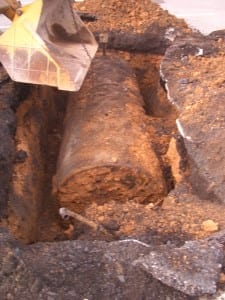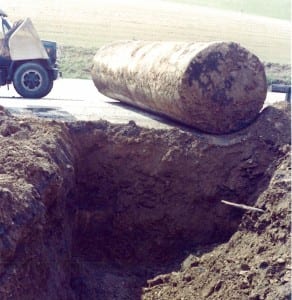Making a claim for leaking UST cleanup costs in Pennsylvania
You just detected a leaking underground storage tank. Do you know how to m ake a claim to cover the cleanup costs? We have helped our clients put together over 100 claim packages for Pennsylvania leaking underground storage tank cleanup costs and will use our experience to help you compile the correct information to make a successful claim.
ake a claim to cover the cleanup costs? We have helped our clients put together over 100 claim packages for Pennsylvania leaking underground storage tank cleanup costs and will use our experience to help you compile the correct information to make a successful claim.
So, you notified the Pennsylvania Department of Environmental Protection (PADEP) hotline and reported the leak (as required by law). Now you have a letter from the PADEP that says you must undertake extensive environmental assessment and remediation activities. What’s next?
Fortunately, if you have a release from an underground storage tank in Pennsylvania, there is a program called the Underground Storage Tank Indemnification Fund (USTIF). The fund will pay all “reasonable” cleanup costs up to $1.5 million with a $5,000 deductible. However, there are a few steps you have to take in order to be eligible. If you get these steps wrong, you may not receive full funding for your claim.
We will take you through the following steps:
- Ensure the release was reported to the PADEP spill hotline within 24 hours of confirming the release.
- Present a written notification to the PADEP within 15 days of the release.
- Call in a claim to USTIF within 60 days of the release.
- Provide information in response to the follow up letter from USTIF.
Information Required by USTIF to Process a Claim for Pennsylvania Leaking Underground Storage Tank Cleanup Costs
USTIF will ask for some general details about when and how the spill happened, if any investigation/remediation was conducted, and if you think there may be third party damages. They don’t ask a lot; most of the details they require come from answering a follow-up call from an adjuster and from an information request letter.
The USTIF Information Request Letter will look a bit like this:
In order to support the claim you have filed with the Pennsylvania Underground Storage Tank Indemnification Fund, please provide the data/information requested below:
- Type of facility (i.e. retail gasoline sales with convenience store, retail sales with repair service, etc.)
- Number of underground tanks, their size, contents, age, material of construction of the tanks and lines at the time of the release (i.e. bare steel, asphalt-coated steel, fiberglass). Type of lines (pressurized or suction), presence of leak detectors, spill and overfill protection. Also, are the tanks all in the same tank pit?
- A history of repairs and upgrades to tanks and lines.
- Indication of when the release or potential release was first suspected and how the problem manifested itself. Please indicate the date the release was confirmed.
- The name, address and phone numbers of the person who discovered the release/problem and any witnesses to the event.

- The cause (source) of the suspected or confirmed release and the time frame of the release. Be exact. Which tank and/or line was involved? Estimated product lost. When did release begin? Provide action(s) taken to investigate and/or abate the release.
- Was the DEP called and did they respond to the site? Please indicate who came out, when, and any instructions received. Name, address, telephone number, and contact of your consulting firm.
- Please indicate remedial activities to date. Further indicate if groundwater was impacted and amount (if any) of soil removed. Provide costs incurred to date and future anticipated costs. If tanks were removed, the cost of such including disposal.
- Any prior history of site contamination. Please also indicate type of heating utilized for building(s) at this site.
- Indicate any damages to third parties and, if applicable, include name, address and type of damage. Is the site served by its own well water?
- Please indicate the procedures performed to comply with regulations concerning leak detection.
- Please supply name, title, and telephone number of person performing stick readings, procedures for tank sticking, product deliveries, and checking for water in the tank. Please indicate if water was ever found in the tanks.
- Please indicate the status of your tank permit. Has it ever been revoked? And if so, why?
- Is there any other pollution insurance in effect for your facility that would provide pollution coverage for this release? If so, please provide the name of your insurance company, their address and phone number, and your policy number.
The following documents must be submitted:
- Copies of any analytical data, well logs, site maps, closure reports, site assessments, etc. performed at this site currently or in the past.
- Daily tank inventories/tank gauging figures and monthly reconciliations for the involved tank/lines for the six month period preceding the discovery of contamination.
- Proof of payment of the USTIF fees, including the throughput fees. An invoice, from around the time of the discovery of contamination, for gas delivery showing the USTIF fee and the canceled check covering payment of that invoice are sufficient proof of payment of the throughput fees.
- Any tank and line tightness tests.
- Latest DEP registration certificate for the involved tanks.
Cleanup costs to comply with PADEP regulations can be astronomical. By putting together a good claim package, your liability may be limited to the $5,000 deductible. If Ambipar Response EMS performs the environmental assessment and cleanup, we accept payment directly from USTIF for all covered costs.
For more information on USTIF, explore their FAQ page.



